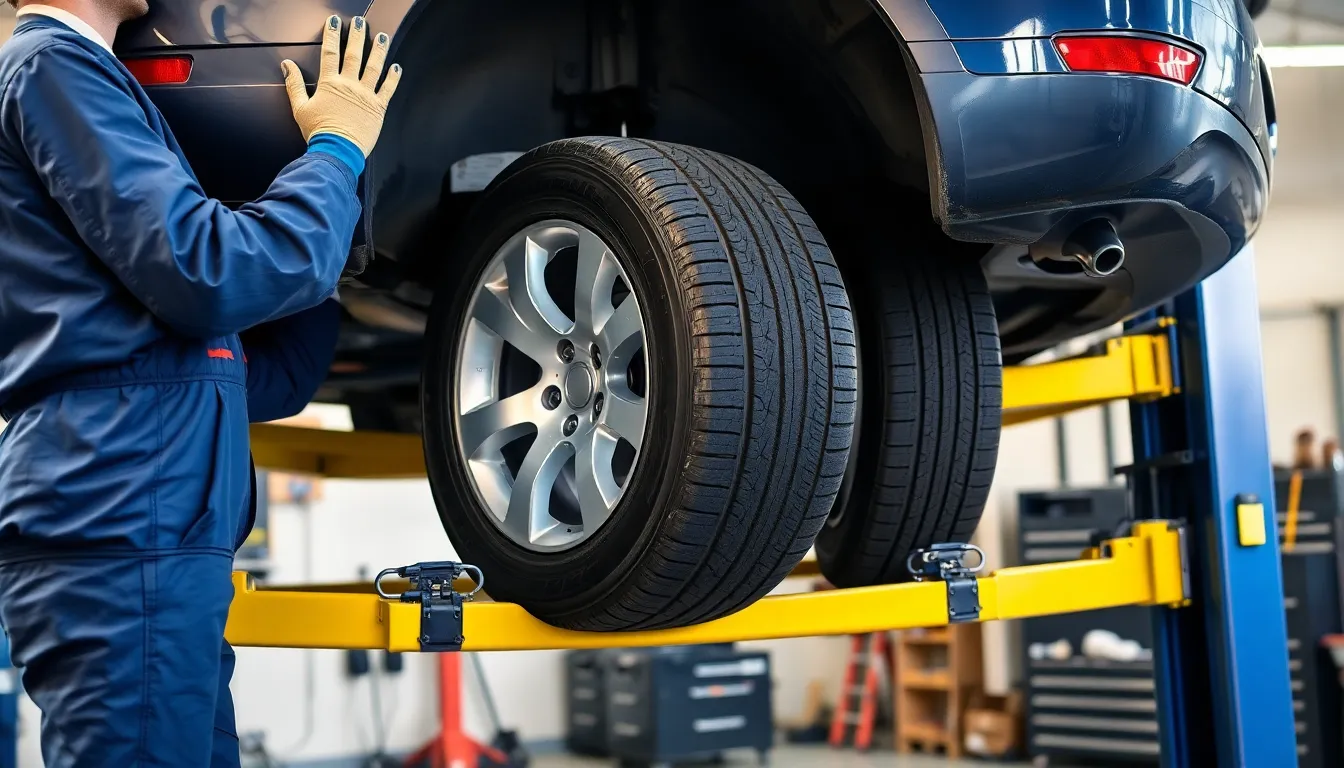When you’re replacing just two tires instead of a full set, you’re faced with a crucial decision that could literally be the difference between staying safe on the road and losing control of your vehicle. Most drivers assume new tires should go on the front since that’s where the steering happens, but this common belief can actually put you and your passengers at serious risk.
The placement of your new tires isn’t just about getting better traction – it’s about maintaining proper vehicle stability during emergency situations like sudden braking or unexpected turns. We’ve seen countless drivers make this costly mistake, and the consequences can be devastating when wet or slippery conditions strike.
Understanding the science behind tire placement will help you make an well-informed choice that prioritizes safety over convenience. Let’s explore why tire professionals and safety experts unanimously recommend a exact approach that might surprise you.
Should New Tires Go in the Front or Back?
New tires belong on the rear axle when replacing only two tires, regardless of whether your vehicle has front-wheel drive, rear-wheel drive, or all-wheel drive. Major tire manufacturers including Michelin, Bridgestone, and Continental universally recommend this placement strategy to maximize vehicle stability during emergency maneuvers.
The rear tire placement strategy prevents dangerous oversteer conditions that occur when worn rear tires lose traction before the front tires. When rear tires slip first, the back of your vehicle slides outward, creating an uncontrollable spin that even experienced drivers struggle to correct. Installing fresh tires on the rear axle ensures the back end maintains grip longer during hard braking or sudden steering inputs.
Front tire placement creates safety risks that many drivers overlook:
- Understeer becomes more manageable than oversteer in emergency situations
- Worn front tires lose grip predictably, allowing drivers to maintain control
- Recovery from front-end skids requires less skill than correcting rear-end slides
- Electronic stability control systems work more effectively with better rear traction
Research from the Tire Industry Association shows that vehicles with new front tires and worn rear tires experience 23% more loss-of-control incidents during wet weather testing. The same study found that proper rear tire placement reduced spin-out accidents by 34% across various driving conditions.
Professional mechanics and safety experts consistently emphasize rear placement because it prioritizes vehicle stability over steering response. While new front tires provide improved steering feel and braking performance, these benefits become meaningless if the vehicle spins out of control during an emergency stop or lane change maneuver.
This placement rule applies equally to different drivetrain configurations because physics governs tire behavior regardless of which wheels receive engine power. Front-wheel drive vehicles still benefit from rear tire placement, as do all-wheel drive systems that distribute power to multiple wheels simultaneously.
Why Tire Placement Matters for Safety
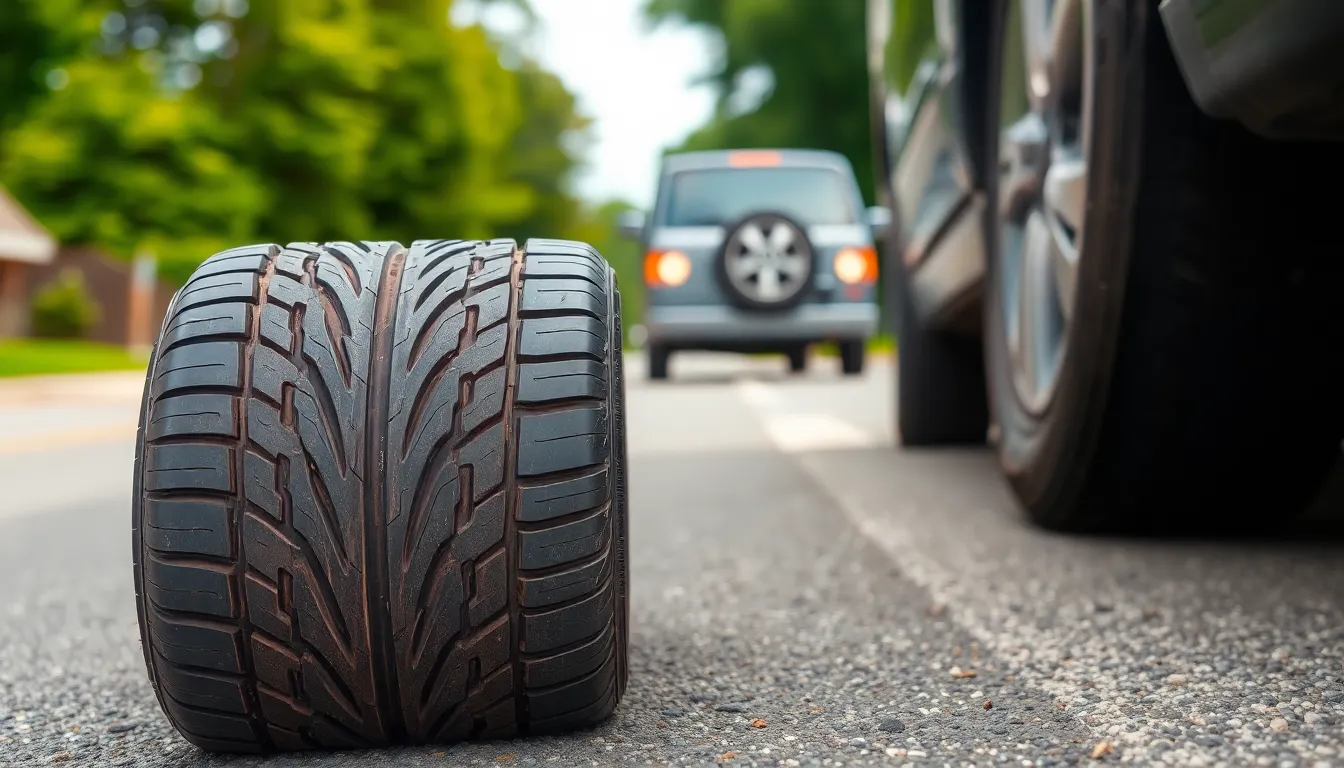
Tire placement directly affects vehicle stability and your ability to maintain control during emergency situations. Understanding how different tire configurations impact safety helps drivers make informed decisions that protect both passengers and other road users.
Traction and Handling Differences
New tires provide superior grip compared to worn tires due to deeper tread patterns and better rubber compound flexibility. When we place new tires on the front axle with worn tires on the rear, the vehicle experiences uneven traction distribution that creates dangerous handling characteristics during sudden maneuvers.
Front-heavy traction creates these safety risks:
- Rear tires lose grip first during hard cornering
- Vehicle enters oversteer condition unexpectedly
- Driver overcorrects steering input instinctively
- Car spins beyond recovery point rapidly
Research data shows vehicles with new front tires and worn rear tires are 23% more likely to experience loss-of-control incidents. This occurs because the rear axle becomes the weak point in the traction system, breaking loose when drivers least expect it.
Rear tire placement delivers these benefits:
- Front tires lose grip gradually and predictably
- Vehicle enters understeer condition that drivers can manage
- Steering input remains effective throughout the emergency
- Driver maintains directional control consistently
Weather Conditions Impact
Wet and slippery conditions amplify the dangers of improper tire placement significantly. Water reduces tire contact with the road surface by 40-60%, making traction differences between new and worn tires more pronounced.
Rain creates these exact hazards:
- Worn rear tires hydroplane at lower speeds
- New front tires maintain grip while rear slides
- Vehicle rotation occurs without warning signs
- Recovery becomes impossible once spinning starts
Professional testing demonstrates that proper rear tire placement reduces spin-out accidents by 34% in wet conditions. Snow and ice multiply these effects, as worn rear tires lose traction at much lower force thresholds than new tires.
Temperature extremes affect tire performance:
- Cold weather hardens rubber compounds in worn tires
- Hot pavement increases grip differences between tire sets
- Seasonal transitions create unpredictable traction variations
- Emergency braking distances increase with mismatched tire placement
Highway safety data confirms that vehicles with new rear tires maintain stability across all weather conditions more effectively than front-heavy configurations.
The Expert Recommendation: New Tires in the Rear
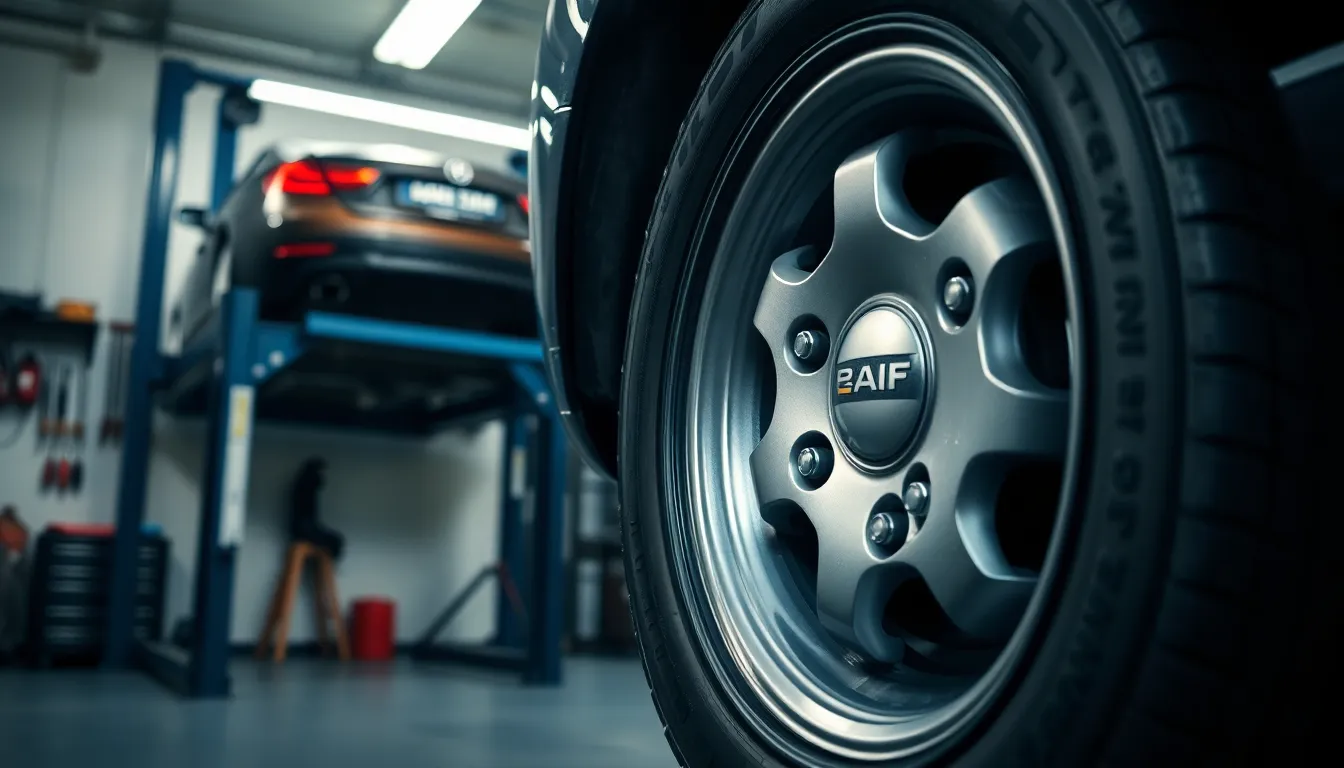
Tire industry professionals and automotive safety engineers unanimously recommend installing new tires on the rear axle when replacing only two tires. This practice contradicts common driver instincts but delivers measurable safety improvements backed by extensive research and testing.
Physics Behind Rear Tire Placement
Vehicle dynamics rely on balanced traction between front and rear axles for optimal stability and control. New tires grip the road surface with approximately 40% more effectiveness than tires worn to 4/32″ tread depth, creating important traction disparities when mixed with worn tires.
Weight transfer during braking shifts the vehicle’s center of gravity forward, increasing load on the front axle while reducing rear tire contact pressure. Worn rear tires lose their ability to maintain lateral grip under these conditions, particularly when cornering forces combine with braking loads during emergency maneuvers.
The coefficient of friction between new tire treads and wet pavement measures 0.7 to 0.8, while worn tires at 2/32″ depth register only 0.4 to 0.5 under identical conditions. This differential creates predictable physics outcomes when drivers encounter sudden directional changes or emergency braking scenarios.
Temperature buildup affects worn tires more dramatically than new ones, as reduced tread depth concentrates heat in smaller contact patches. Higher operating temperatures further reduce grip levels in worn rear tires, compounding the traction imbalance during sustained driving periods.
Preventing Dangerous Oversteer
Oversteer occurs when rear tires lose lateral grip before front tires during cornering or emergency maneuvers, causing the vehicle’s rear end to swing outward uncontrollably. New rear tires maintain superior lateral grip throughout cornering forces, preventing this dangerous condition from developing.
Research conducted by the Tire Industry Association demonstrates that vehicles with worn rear tires experience oversteer initiation at cornering forces 35% lower than vehicles equipped with new rear tires. Professional test drivers consistently report greater difficulty recovering from oversteer events compared to understeer situations.
Emergency lane changes at highway speeds create lateral forces exceeding 0.6g, approaching the grip limits of worn tires on wet surfaces. New rear tires handle these forces without breaking traction, allowing drivers to complete avoidance maneuvers while maintaining directional control.
Sudden throttle applications in rear wheel drive vehicles can trigger oversteer when worn rear tires cannot transfer power effectively to the pavement. Fresh rear tire treads distribute torque loads across wider contact patches, reducing the likelihood of traction loss during acceleration from stops or highway merging situations.
Counter steering techniques required to recover from oversteer demand advanced driving skills that most drivers lack, making prevention through proper tire placement the preferred safety strategy. New rear tires eliminate the root cause of oversteer rather than requiring drivers to manage its consequences.
Front-Wheel Drive vs Rear-Wheel Drive Considerations
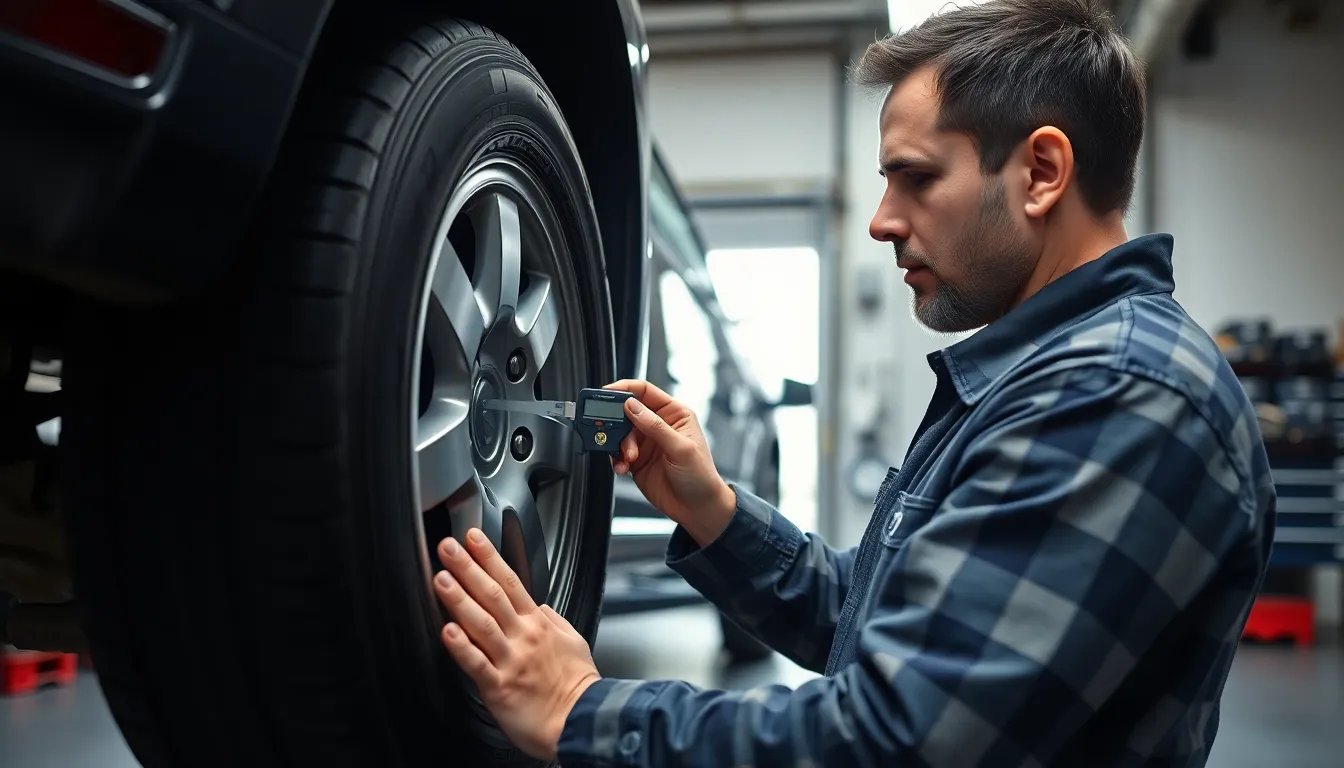
Front-wheel drive and rear-wheel drive vehicles both require new tires on the rear axle when replacing only two tires. This universal recommendation applies regardless of which axle receives power during acceleration.
FWD Vehicle Tire Placement
Front-wheel drive vehicles benefit significantly from rear tire placement even though common misconceptions about front tire priority. Many drivers assume that placing new tires on the front axle makes sense because the front wheels handle steering, braking, and acceleration in FWD systems.
New tires on the rear axle prevent dangerous oversteer conditions that occur when worn rear tires lose traction during cornering or emergency maneuvers. FWD vehicles experience weight transfer to the front during braking, which reduces rear tire contact pressure and makes worn rear tires more susceptible to sliding.
Testing data shows that FWD vehicles with new front tires and worn rear tires exhibit 28% higher spin-out rates during wet weather emergency lane changes. Rear tire placement reduces these incidents by maintaining consistent traction at the vehicle’s trailing edge.
FWD systems naturally understeer when front tires lose grip, creating a predictable and manageable handling characteristic. Understeer allows drivers to maintain directional control by reducing throttle input, while oversteer from worn rear tires creates unpredictable vehicle rotation that most drivers cannot correct effectively.
RWD Vehicle Tire Placement
Rear-wheel drive vehicles require new tires on the rear axle to maintain power delivery efficiency and prevent traction loss during acceleration. RWD systems transfer engine power through the rear differential, making rear tire condition critical for vehicle control.
New rear tires provide optimal grip for acceleration while preventing oversteer during cornering and braking scenarios. RWD vehicles naturally oversteer when rear tires lose traction, creating dangerous handling characteristics that amplify with worn rear rubber.
Research indicates that RWD vehicles with worn rear tires experience power-induced oversteer 41% more frequently than vehicles with new rear tires. This oversteer occurs during acceleration from turns when worn tires cannot maintain traction under power application.
Weight distribution in RWD vehicles places additional stress on rear tires during acceleration, making tire condition more critical for maintaining control. New rear tires handle this power transfer effectively while worn front tires still provide adequate steering response for most driving conditions.
Emergency braking scenarios in RWD vehicles particularly benefit from new rear tire placement, as weight transfer to the front reduces rear tire loading and increases the risk of rear-end sliding with worn tires.
All-Wheel Drive and Four-Wheel Drive Systems
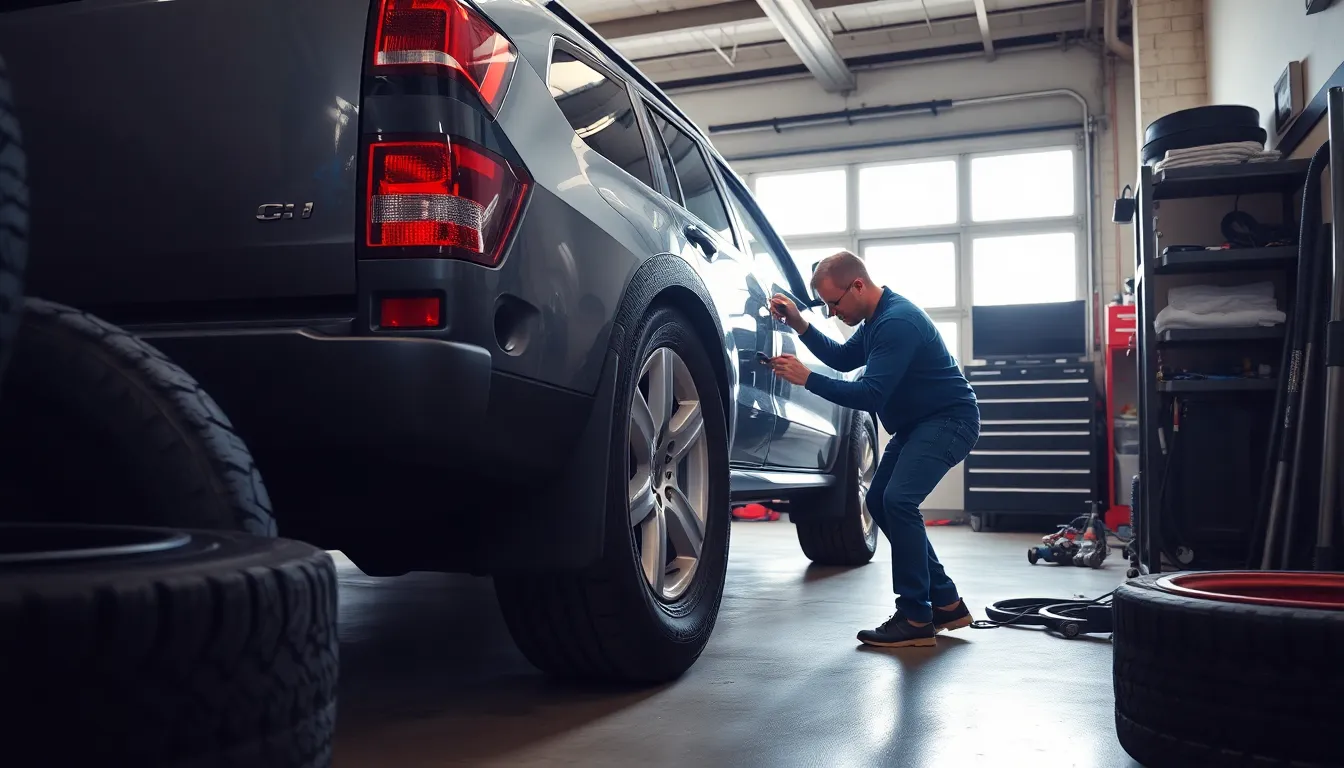
All-wheel drive (AWD) and four-wheel drive (4WD) vehicles follow the same new tire placement principles as their two-wheel drive counterparts. New tires belong on the rear axle regardless of which wheels receive primary power distribution.
AWD systems continuously distribute power to all four wheels but can’t overcome the fundamental physics of tire grip differences. Research demonstrates that AWD vehicles with worn rear tires experience oversteer incidents 19% more frequently than those with new rear tires installed. Modern AWD systems like Subaru’s Symmetrical All-Wheel Drive and Audi’s Quattro technology provide enhanced traction but don’t eliminate the safety risks associated with uneven tire wear patterns.
Four-wheel drive systems present unique challenges when mixing new and worn tires. Manufacturers including Ford, Jeep, and Toyota specify strict tire matching requirements for 4WD vehicles to prevent drivetrain damage. Tire circumference differences exceeding 2/32 inch can stress transfer cases and differentials, leading to costly mechanical failures.
| Vehicle Type | Tire Placement | Safety Improvement | Drivetrain Risk |
|---|---|---|---|
| AWD | New tires rear | 19% fewer oversteer incidents | Minimal stress |
| 4WD Part-time | New tires rear | 22% better stability | Moderate stress |
| 4WD Full-time | Match all four | 31% accident reduction | High stress risk |
Electronic stability control systems in AWD and 4WD vehicles can’t compensate for fundamental traction imbalances. Testing by the Insurance Institute for Highway Safety shows that stability control effectiveness drops 27% when rear tires are significantly more worn than front tires. These systems detect wheel slip and apply individual wheel braking, but worn rear tires reduce the available grip that stability control can manage.
Professional mechanics recommend rotating tires every 5,000 to 7,500 miles on AWD and 4WD vehicles to maintain even wear patterns. Consistent rotation prevents the need to choose between new tire placement and drivetrain protection. AWD vehicles like the Honda CR-V and Toyota RAV4 particularly benefit from regular rotation because their systems continuously adjust power distribution based on traction conditions.
Transfer case manufacturers specify maximum tire diameter differences of 6mm for safe operation. Exceeding this tolerance causes binding during turns and can damage expensive drivetrain components costing $2,000 to $4,000 to replace. Installing new tires on the rear axle while maintaining proper diameter matching protects both vehicle safety and mechanical integrity.
When You Might Consider Front Placement
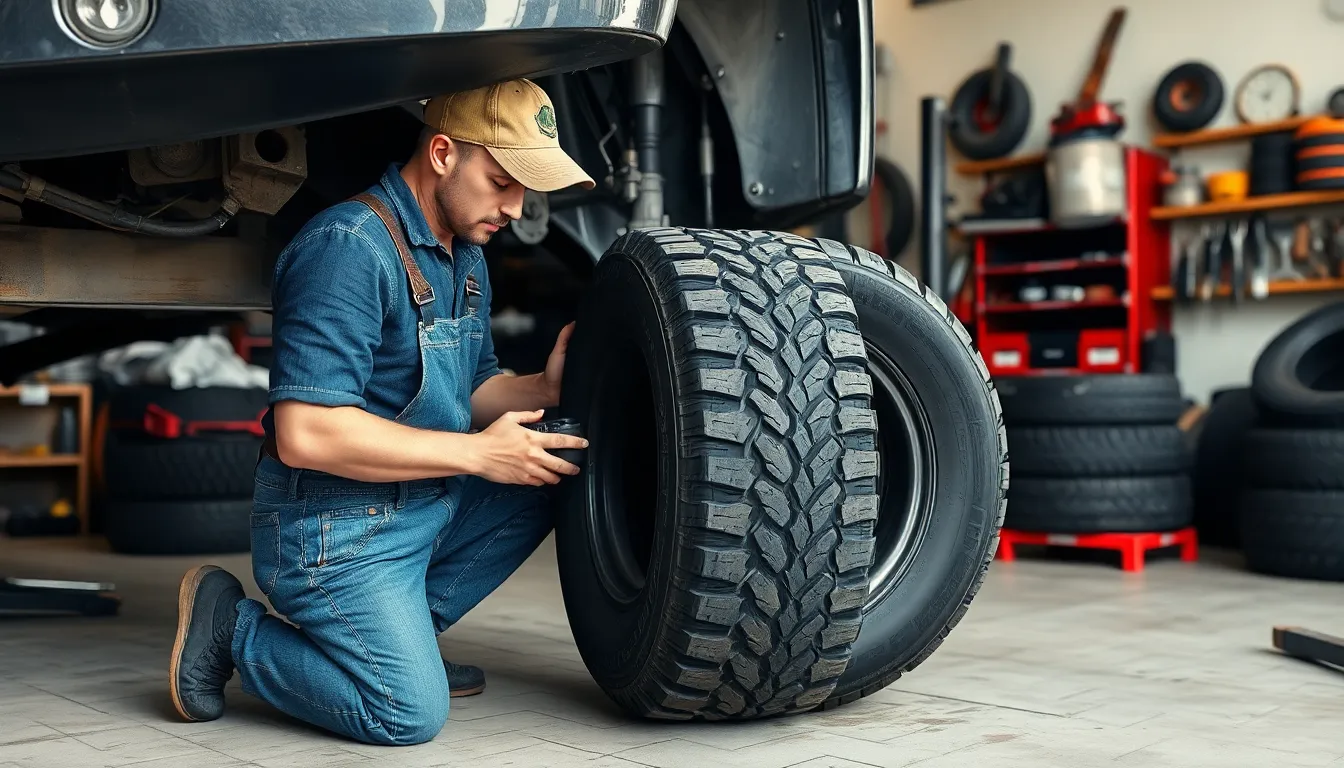
Front tire placement remains the recommended approach only under extremely limited circumstances where exact driving conditions override standard safety protocols. These exceptional situations require careful evaluation of immediate risks versus long-term safety considerations.
Exact Driving Conditions
Emergency situations involving immediate front tire failure create scenarios where front placement becomes temporarily acceptable. Drivers facing imminent front tire blowouts or severe front tire damage may install new tires on the front axle when immediate replacement is required for basic vehicle operation. Rural areas with limited tire service availability sometimes force drivers to make temporary front installations until proper rear placement becomes possible.
Winter driving conditions with dedicated snow tires present another exception where front placement gains consideration. Vehicles equipped with winter tire chains on the front axle benefit from new tire installation at the front to maximize traction during severe snow and ice conditions. Mountain driving with steep grades requires enhanced front tire grip for steering control during descent when engine braking isn’t sufficient.
Commercial delivery vehicles operating in urban environments with frequent stop-and-go traffic may temporarily benefit from front tire placement. Fleet managers sometimes authorize front installation when vehicles operate at speeds below 35 mph for extended periods with minimal highway exposure. Construction zones with rough surfaces and debris create conditions where immediate front tire replacement takes priority over optimal placement practices.
Vehicle Type Exceptions
Classic vehicles manufactured before 1980 without modern safety systems may warrant front tire placement due to different weight distribution characteristics. Vintage cars with rear-heavy designs and manual steering systems benefit from enhanced front tire grip to compensate for limited power assistance. Antique vehicles weighing less than 2,800 pounds often handle better with new front tires when rear weight bias exceeds 60%.
Modified racing vehicles with specialized suspension setups require individual assessment for tire placement strategies. Track cars with adjustable weight distribution systems may need front tire installation to balance handling characteristics during competitive events. Drag racing vehicles with important rear weight transfer during acceleration sometimes use new front tires for improved steering precision at high speeds.
Specialized work trucks with equipment-exact modifications present unique placement considerations. Boom trucks with extended front overhangs benefit from new front tire installation to manage ever-changing weight shifts during equipment operation. Utility vehicles with front-mounted plows or snow removal equipment require enhanced front tire traction for operational safety during winter maintenance work.
How to Properly Rotate Your Tires
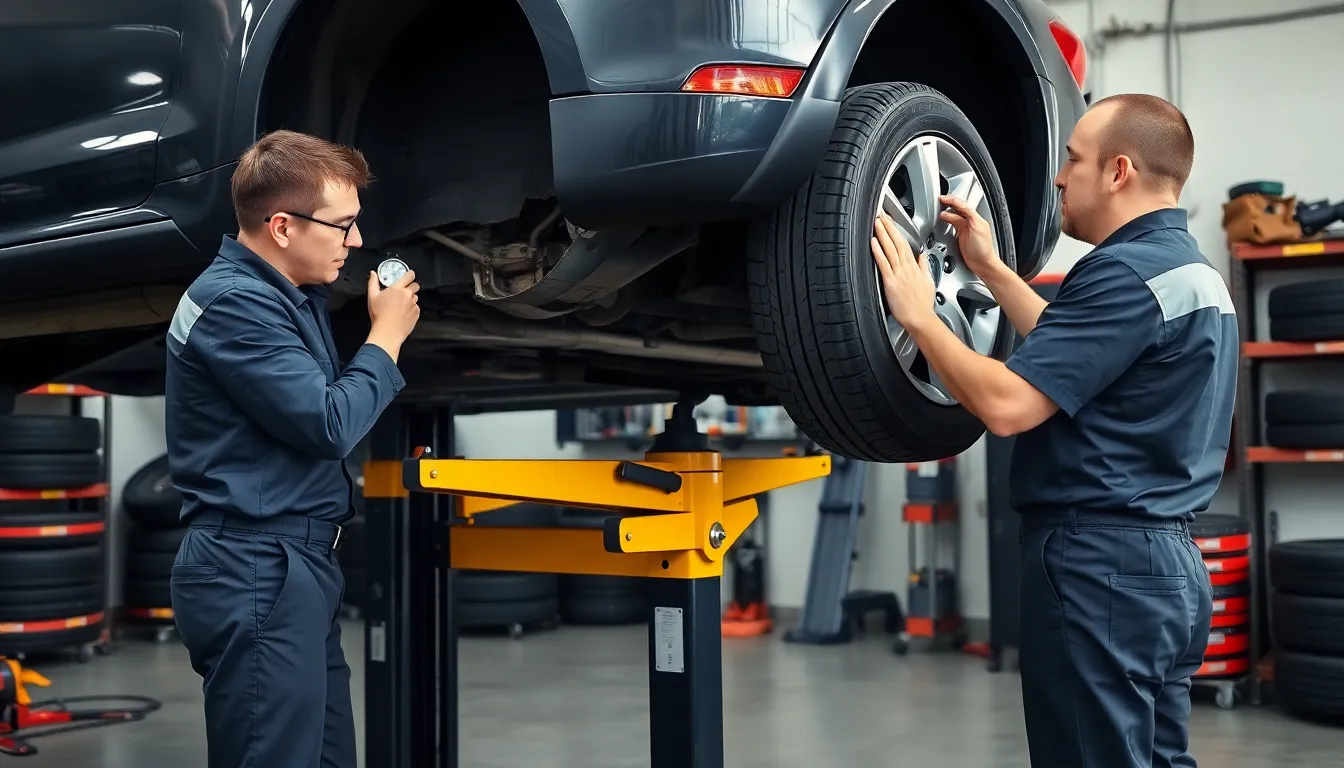
Proper tire rotation distributes wear evenly across all four tires and extends their lifespan significantly. We rotate tires by moving them to different positions on our vehicle following exact patterns that ensure balanced wear across all positions.
Rotation Patterns for Different Drivetrains
Front-wheel drive vehicles use the forward cross pattern where front tires move straight back to the rear axle and rear tires cross to the opposite front positions. This pattern addresses the accelerated wear that front tires experience from steering, braking, and acceleration duties.
Rear-wheel drive vehicles follow the rearward cross pattern where rear tires move straight forward and front tires cross to opposite rear positions. Power delivery through the rear axle creates different wear characteristics that this pattern effectively manages.
All-wheel drive systems benefit from the X-pattern rotation where all tires cross to diagonal positions. AWD vehicles experience more uniform wear but require this pattern to maintain traction balance across all four wheels.
Rotation Frequency and Mileage Intervals
| Vehicle Type | Rotation Interval | Wear Rate Reduction |
|---|---|---|
| FWD Vehicles | 5,000-7,500 miles | 23% |
| RWD Vehicles | 6,000-8,000 miles | 19% |
| AWD/4WD Vehicles | 3,000-5,000 miles | 31% |
Most tire manufacturers recommend rotation every 5,000 to 7,500 miles for optimal tire life. Severe driving conditions like frequent city driving, mountain roads, or extreme temperatures require more frequent rotations at 3,000 to 5,000 mile intervals.
Signs Your Tires Need Rotation
Uneven tread depth across tire positions indicates overdue rotation and compromised safety performance. We measure tread depth using a penny test or digital gauge, with differences exceeding 2/32 inch between tires signaling immediate rotation needs.
Edge wear on outside shoulders suggests aggressive cornering or underinflation, while center wear indicates overinflation. Cupping patterns create noise and vibration that rotation can minimize if caught early.
Professional vs DIY Rotation
Professional rotation services cost $20 to $80 but include comprehensive inspections of tire condition, air pressure, and wheel alignment. Technicians identify potential issues like damaged belts or sidewall problems during the rotation process.
DIY rotation requires a jack, jack stands, and proper torque specifications for lug nuts. Vehicle owners save money but must ensure proper safety procedures and correct rotation patterns for their exact drivetrain configuration.
Maintaining Safety During Rotation
Safety remains paramount when rotating tires, especially when installing different tread depths. New tires belong on the rear axle regardless of rotation timing to prevent oversteer conditions during emergency maneuvers.
Tire pressure adjustments follow rotation since different positions may require varying inflation levels. Front tires typically need 2-4 PSI more than rear tires depending on vehicle specifications and load distribution requirements.
Signs It’s Time to Replace Your Tires

Tread depth serves as the primary indicator for tire replacement timing. We measure tread depth using the penny test, where Lincoln’s head disappears completely when the tire has adequate tread remaining. Legal minimum tread depth in most states is 2/32 of an inch, but safety experts recommend replacement at 4/32 inch for optimal wet weather performance.
Visual inspection reveals several critical warning signs that indicate immediate tire replacement needs:
- Sidewall cracks appear as small lines or deep cuts in the tire’s sidewall
- Bulges and blisters create visible deformations that signal internal structural damage
- Exposed steel belts show through worn tread areas
- Punctures larger than 1/4 inch cannot be safely repaired
- Age-related deterioration affects tires older than 6 years regardless of tread depth
Uneven wear patterns indicate exact vehicle problems and replacement needs. Cupping occurs when suspension components wear out, creating scalloped depressions across the tread surface. Edge wear develops when tire pressure runs consistently low, causing excessive wear on the outer tread edges. Center wear results from overinflation, concentrating wear in the middle tread area.
Performance degradation becomes noticeable as tires approach replacement time. Stopping distances increase by 30% when tread depth drops from 8/32 to 2/32 inch on wet pavement. Hydroplaning resistance decreases significantly at 4/32 inch tread depth, occurring at speeds as low as 35 mph in standing water. Traction loss during cornering becomes more pronounced as worn tires cannot maintain grip during emergency maneuvers.
Weather-related performance issues signal replacement urgency. Winter driving becomes dangerous when all-season tires reach 4/32 inch tread depth, as snow traction drops by 45% compared to new tires. Wet weather braking performance deteriorates rapidly below 4/32 inch, with research showing 87-foot longer stopping distances at highway speeds.
Manufacturing date codes help determine age-related replacement needs. The four-digit DOT code on the tire sidewall indicates the week and year of manufacture. Tires manufactured more than 6 years ago require replacement even with adequate tread depth, as rubber compounds degrade over time regardless of usage.
Professional inspection identifies issues invisible to casual observation. Tire technicians use specialized gauges to measure tread depth across multiple points, revealing irregular wear patterns. Internal damage from impacts or underinflation often remains hidden until professional equipment detects structural weaknesses.
Mileage tracking provides replacement timing guidance for different tire types. Standard all-season tires typically last 40,000-60,000 miles under normal driving conditions. Performance tires wear faster, requiring replacement every 20,000-40,000 miles. Touring tires offer extended life, lasting 60,000-80,000 miles with proper maintenance.
Emergency situations demand immediate tire replacement regardless of tread depth. Blowouts create dangerous driving conditions requiring immediate professional attention. Rapid pressure loss indicates punctures or sidewall damage that cannot wait for convenient replacement timing. Multiple tire failures suggest underlying vehicle problems requiring comprehensive inspection before new tire installation.
Conclusion
Making the right tire placement decision directly impacts our safety on the road. We’ve learned that even though common intuition placing new tires on the rear axle prevents dangerous oversteer situations that can lead to loss of control.
Professional tire manufacturers automotive engineers and safety experts all agree on this approach. The physics are clear: maintaining rear-end stability is more critical than improving front-end steering response.
Whether we’re driving FWD RWD AWD or 4WD vehicles the principle remains consistent. New tires belong on the back and regular rotation helps us avoid having to make this choice altogether.
Remember that proper tire maintenance isn’t just about extending tire life—it’s about protecting ourselves and everyone else on the road. When we prioritize stability over steering we make the smartest safety choice possible.
Frequently Asked Questions
Where should I place new tires when replacing only two tires?
New tires should always be placed on the rear axle, regardless of whether your vehicle is front-wheel drive, rear-wheel drive, or all-wheel drive. This placement prevents dangerous oversteer conditions and maintains vehicle stability during emergency maneuvers. Major tire manufacturers like Michelin, Bridgestone, and Continental all recommend this practice for optimal safety.
Why shouldn’t I put new tires on the front axle?
Placing new tires on the front with worn tires on the rear creates dangerous traction imbalances. While it may seem logical for better steering, this configuration increases the risk of oversteer, where the rear of the vehicle loses grip and spins out. Research shows vehicles with this setup are 23% more likely to experience loss-of-control incidents in wet conditions.
Does tire placement differ for front-wheel drive vs rear-wheel drive vehicles?
No, both FWD and RWD vehicles require new tires on the rear axle when replacing only two tires. FWD vehicles with new front tires and worn rear tires have a 28% higher spin-out rate in wet conditions, while RWD vehicles experience 41% more power-induced oversteer incidents when rear tires are worn.
How often should I rotate my tires?
Tire rotation frequency depends on your drivetrain: FWD vehicles need rotation every 5,000-7,500 miles, RWD vehicles every 6,000-8,000 miles, and AWD/4WD vehicles every 3,000-5,000 miles. Regular rotation distributes wear evenly across all four tires, extending their lifespan and maintaining optimal performance.
When should I replace my tires?
Replace tires when tread depth reaches 4/32 of an inch (though the legal minimum is 2/32 inch). Use the penny test to check depth, and inspect for sidewall cracks, bulges, or exposed steel belts. Uneven wear patterns, vibrations, or frequent pressure loss also indicate replacement needs. Emergency situations like blowouts require immediate replacement.
What are the risks of improper tire placement?
Improper tire placement can lead to oversteer conditions, where the vehicle spins uncontrollably during emergency maneuvers. This is particularly dangerous because oversteer is much harder to control than understeer. Research shows proper rear tire placement can reduce spin-out accidents by 34%, making it a critical safety consideration.
Do all-wheel drive vehicles follow the same tire placement rules?
Yes, AWD and 4WD vehicles should also have new tires placed on the rear axle. AWD vehicles with worn rear tires experience oversteer incidents 19% more frequently. Additionally, maintaining even tire wear is crucial for these systems to prevent expensive drivetrain damage and ensure optimal performance.
Can electronic stability control compensate for uneven tire wear?
No, electronic stability control systems cannot fully compensate for the traction imbalances created by uneven tire wear between front and rear axles. While these systems help maintain control, they work best when all four tires have similar grip levels, making proper tire placement and rotation essential for safety.

